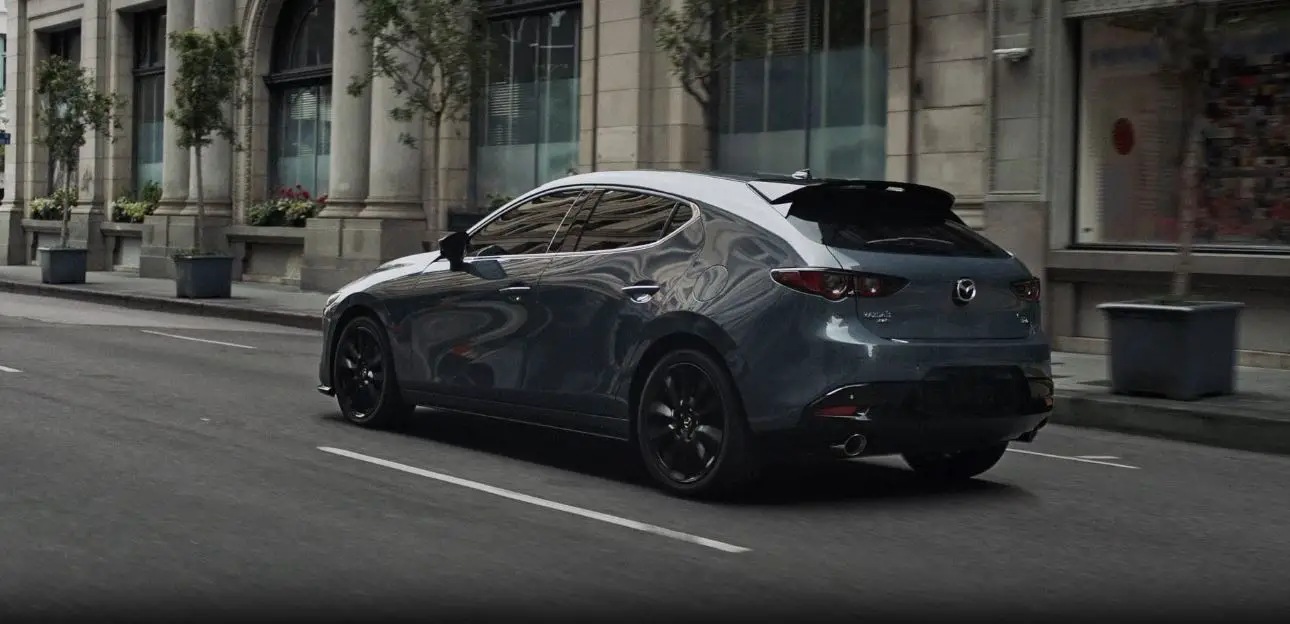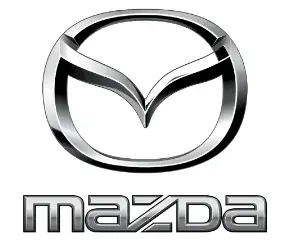Mazda 3 Hatchback 2023 Lane-keep Assist System User Manual
A sophisticated Lane-keep Assist System is included with the Mazda 3 Hatchback 2023, demonstrating Mazda’s dedication to safety and innovation. This innovative technology helps drivers maintain optimal lane positioning and lowers the possibility of unintentional lane exits. The Lane-keep Assist System actively monitors the surroundings of the vehicle with the help of a variety of sensors and clever features, and it gently steers the car to maintain its position inside the lane. The Lane-keep Assist System continuously scans the road ahead and recognizes lane lines using a forward-facing camera. The vehicle’s position in relation to those marks is then examined, and if any unintentional drifting or course deviation is found, timely alarms and remedial actions are given. Drivers benefit from this proactive strategy by staying alert and attentive, especially during lengthy highway drives or when driver tiredness may be an issue.
Lane-keep Assist System
Lane-keep Assist System (LAS)
The LAS provides steering assistance to help the driver stay within the vehicle lane if the vehicle might be deviating. The forward sensing camera (FSC) detects the white lines (yellow lines) of the vehicle lane in which the vehicle is travelling and if the system determines that the vehicle may deviate from its lane, it operates the electric power steering to assist the driver’s steering operation. The system also alerts the driver by displaying an alert on the multi-information display. Use the system when you drive the vehicle on roads with white (yellow) lines such as expressways and highways.
The LAS provides steering assistance to help the driver stay within the vehicle lane if the vehicle might be deviating. The forward sensing camera (FSC) detects the white lines (yellow lines) of the vehicle lane in which the vehicle is travelling and if the system determines that the vehicle may deviate from its lane, it operates the electric power steering to assist the driver’s steering operation. The system also alerts the driver by displaying an alert on the multi-information display. Use the system when you drive the vehicle on roads with white (yellow) lines such as expressways and highways.
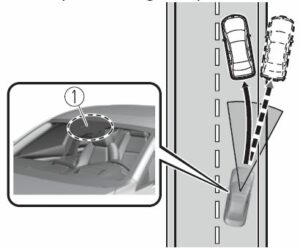
WARNING
Do not rely completely on the LAS:
- The LAS is not an automated driving system. In addition, the system is not designed to compensate for a driver’s lack of caution, and over-reliance on the system could lead to an accident.
- The functions of the LAS have limitations. Always stay on course using the steering wheel and drive with care.
- Do not use the LAS under the following circumstances, otherwise, it may result in an accident.
- The vehicle is driven on slippery roads such as icy or snow-covered roads, and unpaved roads.
- Tires of a different specified size are used, such as a temporary spare tire.
- Tires with insufficient tread are used.
- The tire pressures are not adjusted to the specified pressure.
- The vehicle is being used to tow a camper or boat trailer.
- Tire chains are used.
- The vehicle is driven on roads with lane lines other than white (yellow) lines, such as an expressway.
CAUTION
Heed the following cautions so that the LAS can operate normally.
- Do not modify the vehicle’s suspensions.
- Always use tires of the specified type and size for the front and rear wheels. Consult an Authorized Mazda Dealer for tire replacement.
- NOTE
The system may not operate normally under the following conditions. - The white (yellow) lane lines are less visible because of dirt or paint flaking.
- White (yellow) lane lines are less visible because of bad weather (rain, fog, or snow).
- The vehicle is driven on a temporary lane or section with a closed lane resulting from construction where there might be multiple white
(yellow) lane lines, or they are interrupted. - The camera picks up an obscure line, such as a temporary line being used for construction, or because of shade, unbelted snow, or grooves filled with water.
- The surrounding brightness suddenly changes such as when entering or exiting a tunnel.
- Back-light is reflected off the road surface.
- The road surface is wet and shiny after rain, or there are puddles on the road.
- The width of a lane is excessively narrow.
- The vehicle is driven on roads with tight curves.
- Heavy luggage is loaded in the trunk/luggage compartment or on the rear seat causing the vehicle to tilt.
- The vehicle is driven through a fork in the road or a junction.
- The shade of a guardrail parallel to a white (yellow) lane line is cast on the road.
- The illumination of the headlights is weakened because of dirt or the optical axis is deviated at night.
- The road is excessively uneven.
- The vehicle is shaken after hitting a road bump.
- A vehicle in front of your vehicle is running near a white (yellow) lane line making it less visible.
The windshield is dirty or foggy. - Strong light is directed from the front of the vehicle (such as sunlight, or headlights (high-beam) of on-coming vehicles).
System Operation
When the ignition is switched ON, the i-ACTIVSENSE status symbol (warning/risk avoidance support system) (white) turns on and the system goes on standby.
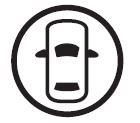
NOTE
If the i-ACTIVSENSE status symbol (warning/risk avoidance support system) (white) does not turn on, the system is canceled using the
i-ACTIVSENSE OFF switch or the personalization feature.
Operation conditions
When all of the following conditions are met, the i-ACTIVSENSE status symbol (warning/risk avoidance support system) on the multi-information display changes from white to green and the system becomes operational.
- The vehicle speed is about 64 km/h (40 mph) or faster.
- The system detects white (yellow) lane lines.

NOTE
When the system does not detect a white (yellow) lane line on one side only, the system does not operate on the side that is not being detected.
When temporarily cancelling the system
The LAS goes on standby in the following cases: The LAS operation is automatically restored when the system’s operation conditions are met.
- The system cannot detect white (yellow) lane lines.
- The vehicle speed is less than about 56 km/h (35 mph).
- The turn signal lever is operated.
- The accelerator pedal is depressed abruptly.
- The TCS/DSC is operating.
- The TCS/DSC is turned off.
- The steering wheel is operated.
- The brake pedal is operated.
The function is temporarily stopped.
The LAS stops functioning in the following cases:
- The temperature in the forward sensing camera (FSC) is too high or too low.
- The windshield around the forward sensing camera (FSC) is foggy.
- The windshield around the forward sensing camera (FSC) is blocked by an obstruction, causing poor forward visibility.
- Strong light (such as sunlight, or headlights (high-beam) of on-coming vehicles) is directed at the forward sensing camera (FSC).
System malfunction
If there is a problem with the system, the i-ACTIVSENSE status symbol (warning/risk avoidance support system) (white) and the i-ACTIVSENSE warning indication/warning light on the multi-information display turns on and a message is indicated. Refer to the i-ACTIVSENSE Status Symbol (Warning/Risk Avoidance Support System).
Steering Wheel Operation Assist
When the system determines that the vehicle might be deviating from its lane, the steering wheel operation assist operates. The system notifies the driver that it provided steering wheel operation assistance on the multi-information display and the active driving display. Multi-information display (Basic display)
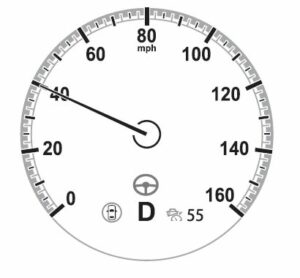
Multi-information display (i-ACTIVSENSE display)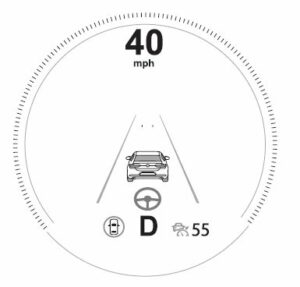
Active driving display

NOTE
- When the driver operates the steering wheel while the steering wheel operation assist is operating, the steering wheel operation assistance is cancelled.
- System Canceling
The LAS can be set to inoperable. - (If only the LAS is turned off)
Refer to the Settings section in the Mazda Connect Owner’s Manual.
(If the LAS is turned off by operating the i-ACTIVSENSE OFF switch) Refer to i-ACTIVSENSE OFF Switch on page 4-100.
NOTE
If the ignition is switched OFF while you have cancelled the system using the i-ACTIVSENSE OFF switch, the system is automatically enabled the next time the ignition is switched ON. However, if the system is cancelled using the personalization features, the system is not automatically enabled.
Smart Brake Support
The SBS is a system designed to detect target objects using sensors and cameras equipped on the vehicle and to reduce damage in the event of a collision by operating the brake control if there is the possibility of your vehicle colliding with a target object. One part of the SBS functions when you are driving forward and the other part functions when you are driving in reverse.
- Refer to Forward drive detection.
- Refer to Reverse drive detection.
Forward drive detection
When you are driving forward, the following functions of the Smart Brake Support (SBS) operate.
- Forward detection function
WARNING
Do not rely completely on the SBS:
The SBS is only designed to reduce damage in the event of a collision. The system may not operate normally depending on the target object, weather conditions, or traffic conditions. Over-reliance on the system leading to the accelerator pedal or brake pedal being mistakenly operated could result in an accident.
CAUTION
In the following cases, turn the SBS off to prevent a misoperation.
- The vehicle is being towed or towed by another vehicle.
- The vehicle is driven on rough roads such as in areas where there is grass and foliage or off-road.
NOTE
During the SBS brake control, the brake pedal may move rearward or become stiff. The brakes are operating, but continue to depress the brake pedal.
Forward detection function
The forward detection function is designed to reduce damage in the event of a collision with target objects at the front. The forward detection function detects target objects (vehicles ahead, pedestrians, and bicycles) using the front radar sensor and the Forward Sensing Camera (FSC). If there is a possibility of your vehicle colliding with a target object at the front, you are notified of possible danger by a warning sound and a warning indication on the display. Furthermore, if the possibility of a collision increases, brake control is performed to reduce damage in the event of a collision. In addition, when the driver depresses the brake pedal, the brakes are applied firmly and quickly to assist.
(Vehicles with Driver Monitoring (DM))
If the system determines that the driver is not paying attention to the road, it activates the collision warning earlier than normal.
Operation conditions
The forward detection function operates when all of the following conditions are met.
- The ignition is switched ON.
- The SBS is on.
- (Object is vehicle ahead)
The vehicle speed is about 4 km/h (3 mph) or higher. - (Object is a pedestrian or bicycle) The vehicle speed is between about 10 and 80 km/h (6.3 to 49 mph).
- The DSC does not operate.
NOTE
- When any of the following conditions is met, the forward detection function may not operate.
- If there is the possibility of hitting only a part of a vehicle or obstruction ahead.
- You are driving your vehicle at the same speed as the vehicle ahead.
- When the driver deliberately performs driving operations N(accelerator operation, steering wheel operation).
- The accelerator pedal is depressed abruptly.
- The brake pedal is depressed.
- The steering wheel is being operated.
- (Automatic transmission)
The selector lever is being shifted. - The turn signal lever is being operated.
- Warnings and messages, such as a dirty windshield, related to the Forward Sensing Camera (FSC) or front radar sensor are being displayed on the multi-information display.
- When any of the following conditions is met, the forward detection function may operate.
- There is an object in the road at the entrance to a curve (including guardrails and snow banks).
- Passing an approaching vehicle while rounding a curve.
- When crossing a narrow bridge, going under a low overhang, or passing through a narrow gate, a car washing machine, or a tunnel.
- When passing through a toll gate.
- When entering an underground parking area.
- There is a metal object, bump, or protruding object on the road.
- If you suddenly come close to a vehicle ahead.
- An animal, wall, or standing tree is detected.
- While the system is operating, the driver is notified by the multi-information display and the active driving display.
- If a malfunction is detected or the system temporarily stops the function due to dirt on the sensors or cameras, the i-ACTIVSENSE warning light turns on and a message is displayed on the multi-information display.
- (Manual transmission)
On a manual transmission vehicle, the engine stops if the clutch pedal is not depressed when the vehicle is stopped by the SBS brake operation. - If the vehicle is stopped by the SBS brake operation and the brake pedal is not depressed, the SBS brake is automatically released after about 2 seconds.
Collision warning
If there is the possibility of your vehicle colliding with a target object at the front, the warning sound is activated continuously and a warning is 4-170 *Some models displayed on the multi-information display and the active driving display. Multi-information display.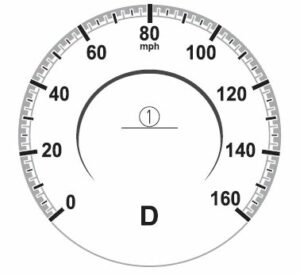
- “BRAKE!” message is displayed Active driving display*

- “BRAKE!” message is displayed N
NOTE
- During brake control and brake assist operation, the collision warning sound is activated intermittently.
- The operation distance and volume of the collision warning can be changed.
Refer to the Settings section in the Mazda Connect Owner’s Manual.
Reverse drive detection
When you are driving in reverse, the following functions of the Smart Brake Support (SBS) operate.
- Rearward detection function
- Rear crossing
WARNING
Do not rely completely on the SBS: The SBS is only designed to reduce damage in the event of a collision. Over reliance on the system leading to the accelerator pedal or brake pedal being mistakenly operated could result in an accident.
Heed the following cautions so that the SBS can operate normally:
- Do not apply stickers (including transparent stickers) to the areas around the rear side radar sensors and the rear ultrasonic sensors. Otherwise, a rear side radar sensor and a rear ultrasonic sensor may not be able to detect vehicles and obstructions correctly which could result in an accident.
- Do not disassemble the rear side radar sensors and rear ultrasonic sensors.
- If you recognize scratches around the rear side radar sensors and rear ultrasonic sensors, stop using the SBS immediately and always have the vehicle inspected by an Authorized Mazda Dealer.
Consult an Authorized Mazda Dealer for rear bumper removal/installation.
Do not modify the suspension:
If the vehicle height or inclination is changed, the SBS may not operate correctly because it cannot detect obstructions correctly.
Do not hit the rear side radar sensors and rear ultrasonic sensors forcefully:
When washing the vehicle, do not spray highly pressurized water against the rear side radar sensors and the rear ultrasonic sensors, or rub them strongly. In addition, do not hit the rear bumper forcefully when loading and unloading cargo. Otherwise, the system will be unable to detect obstructions correctly and the SBS may not operate normally.
CAUTION
- In the following cases, turn the SBS off to prevent a mis-operation.
- A trailer is pulled or an accessory such as a bicycle carrier is installed to the rear of the vehicle.
- The vehicle is driven on rough roads such as in areas where there is grass and foliage or off-road. Refer to Stopping the Smart Brake Support (SBS) System Operation on page 4-176.
- Always use tires for all wheels that are of the specified size, and the same manufacture, brand, and tread pattern. In addition, do not use tires with significantly different wear patterns on the same vehicle. If such improper tires are used, the SBS may not operate normally.
NOTE
During the SBS brake control, the brake pedal may move rearward or become stiff. The brakes are operating, but continue to depress the brake pedal.
Rearward detection function
The rearward detection function is designed to reduce damage in the event of a collision with a target object when reversing.
The rearward detection function detects obstructions using the rear ultrasonic sensors. In addition, if there is the possibility of your vehicle colliding with a target object at the rear while you are driving in reverse, you are notified of possible danger by a warning sound and a warning indication on the display. Furthermore, if the possibility of a collision increases, brake control is performed to reduce damage in the event of a collision.
WARNING
Always check the surrounding area visually when reversing the vehicle:
The operation of the rearward detection function has certain limitations. Therefore, the function might not operate or it might be delayed even if there is a target object at the rear of your vehicle. Always make it your responsibility as a driver to check the rear.
Operation conditions
The rearward detection function operates when all of the following conditions are met.
- The engine is running.
- The SBS is on.
- (Automatic transmission)
- The selector lever is in the R position.
- (Manual transmission)
The shift lever is in the R position. - The vehicle speed is about 2 km/h (2 mph) to 8 km/h (4 mph).
- There is no problem with the DSC.
NOTE
- When any of the following conditions is met, the rearward detection function may not operate.
- Directly after the engine starts.
- The height of the obstruction is low such as low walls or trucks with low loading platforms.
- The height of the obstruction is high such as trucks with high loading platforms.
- The obstruction is not as large as a vehicle or wall.
- The obstruction is thin such as a signpost.
- The surface of the obstruction is not pointed vertically relative to your vehicle.
- The obstruction is soft such as a hanging curtain or snow stuck to a vehicle.
‘The obstruction is shaped irregularly.
‘The obstruction is extremely close.
‘When any of the following conditions is met, the rearward detection function may not operate normally.
‘Snow, ice, or mud adheres to the area around a rear ultrasonic sensor.- The vehicle posture is unstable due to sudden operation of the steering wheel, accelerator pedal, or brake pedal.
- There is another obstruction near one obstruction.
- During inclement weather such as rain, fog, and snow.
- High or low humidity.
- High or low temperatures.
- Strong winds.
- The path of travel is not flat.
- Heavy luggage is loaded in the luggage compartment or on the rear seat and the vehicle is tilted.
- Objects such as a wireless antenna, fog light, or illuminated license plate is installed near a rear ultrasonic sensor.
- The orientation of a rear ultrasonic sensor has deviated for reasons such as a collision.
- The vehicle is affected by other sound waves such as the horn, engine noise, or rear ultrasonic sensor of another vehicle.
- When any of the following conditions is met, the rearward detection function may operate.
- Reversing towards a steep ascending slope.
- There are grating, wheel blocks, a road curb, or a bump.
- There is a hanging curtain or railroad crossing gate.
- Reversing near objects such as foliage, barriers, vehicles, walls, or fences.
- The vehicle is driven on rough roads such as in areas where there is grass and foliage or off-road.
- When reversing through low gates, narrow gates, car washing machines, tunnels, or into a mechanical parking garage.
- A towing bar is installed or a trailer is connected.
- (Manual transmission)
- On a manual transmission vehicle, the engine stops if the clutch pedal is not depressed when the vehicle is stopped by the SBS brake operation.
- If the vehicle is stopped by the SBS brake operation and the brake pedal is not depressed, the SBS brake is automatically released after about 2 seconds.
Collision warning
If there is the possibility of your vehicle colliding with a vehicle approaching from the rear on the left or right, or from the rear while you are driving in reverse, a warning sound is activated continuously and a warning is displayed on the multi-information display and the active driving display. Multi-information display.
- “BRAKE!” message is displayed
Active driving display*
- “BRAKE!” message is displayed
NOTE
During brake control, the collision warning sound is activated intermittently.
Rear crossing
The Rear Crossing detection function is designed to reduce the damage in the event of a collision with a vehicle approaching from the rear sides while driving in reverse.
The Rear Crossing detection function detects approaching vehicles using the rear side radar sensors. If there is the possibility of your vehicle colliding with a vehicle approaching from the rear sides while you are driving in reverse, you are notified of possible danger by a warning sound and a warning indication on the display. Furthermore, if the possibility of a collision increases, brake control is performed to reduce damage in the event of a collision.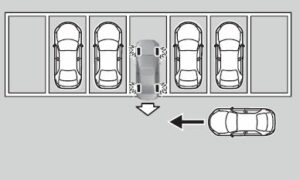
WARNING
Always check the surrounding area visually when reversing the vehicle: The operation of the Rear Crossing detection function has certain limitations. Therefore, the function might not operate or it might be delayed even if there is a vehicle passing through the rear of your vehicle. Always make it your responsibility as a driver to check the rear.
Do not rely completely on the rear-crossing detection function:
The Rear Crossing detection function operates on vehicles while you are driving in reverse. It will not operate on walls, pedestrians, or animals.
Operation conditions
The Rear Crossing detection function operates when all of the following conditions are met.
- The engine is running.
The SBS is on. - (Automatic transmission)
The selector lever is in the R position. - (Manual transmission)
The shift lever is in the R position. - The vehicle speed is about 10 km/h (6.2 mph) or slower.
- The vehicle speed of an approaching vehicle is about 3 km/h (2 mph) or faster.
- There is no problem with the DSC.
NOTE
- When any of the following conditions is met, the i-ACTIVSENSE warning indication/warning light is turned on and the system operation is stopped. If the i-ACTIVSENSE warning indication/warning light remains on, have the vehicle inspected by an Authorized Mazda Dealer as soon as possible.
- There is a problem with the system.
- A large deviation in the installation position of a rear-side radar sensor on the vehicle has occurred.
- Snow, ice, or mud is adhering around a rear-side radar sensor.
- The temperature around a rear-side radar sensor is high.
- Driving on snow-covered roads for long periods.
- The battery voltage has decreased.
- When any of the following conditions is met, the Rear Crossing detection function will not detect approaching vehicles or they may be difficult to detect.
The rear side radar sensor detection area is obstructed by a nearby wall or parked vehicle. (Reverse the vehicle to a position where the radar sensor detection area is no longer obstructed.)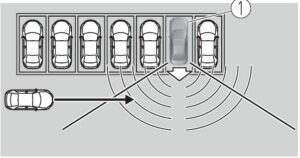
- A vehicle is approaching directly from the rear of your vehicle.
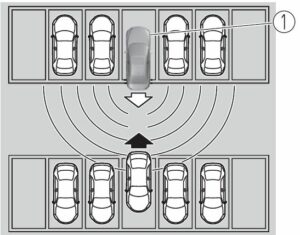 Your vehicle
Your vehicle
- The vehicle is parked on a slant.
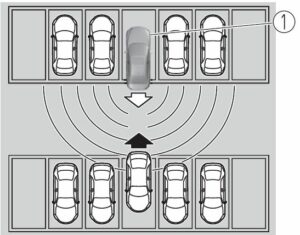
- A vehicle is approaching from the opposite direction on a steep gradient.
- Your vehicle
- Directly after the engine starts.
- Just after the SBS operation has been enabled using [Settings] in Mazda Connect.
- Radio wave interference from a radar sensor equipped on a vehicle parked nearby.
- When any of the following conditions is met, the Rear Crossing may operate.
- There is a hanging curtain or railroad crossing gate.
- Reversing near objects such as foliage, barriers, vehicles, walls, or fences.
- The vehicle is driven on rough roads such as in areas where there is grass and foliage or off-road.
- When reversing through low gates, narrow gates, car washing machines, or tunnels.
- A towing bar is installed or a trailer is connected.
- (Manual transmission)
- On a manual transmission vehicle, the engine stops if the clutch pedal is not depressed when the vehicle is stopped by the SBS brake operation.
- If the vehicle is stopped by the SBS brake operation and the brake pedal is not depressed, the SBS brake is automatically released after about 2 seconds.
Collision warning
If there is the possibility of your vehicle colliding with a vehicle approaching from the rear on the left or right, or from the rear while you are driving in reverse, a warning sound is activated continuously and a warning is displayed on the multi-information display and the active driving display. Multi-information display.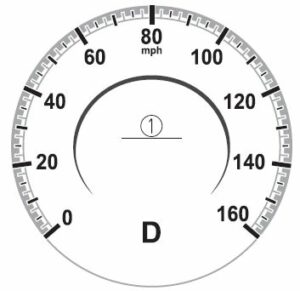
- “BRAKE!” message is displayed Active driving display*

- “BRAKE!” message is displayed
NOTE
During brake control, the collision warning sound is activated intermittently.
Stopping the Smart Brake Support (SBS) System Operation
The SBS can be changed to inoperable.
Refer to the Settings section in the Mazda Connect Owner’s Manual.
When the SBS is canceled, the SBS OFF indicator light turns on.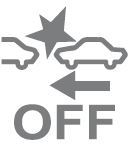
NOTE
When the ignition is switched OFF while the SBS forward drive detection is cancelled, the SBS forward drive detection is automatically enabled the next time the ignition is switched ON.
360° View Monitor
The 360° View Monitor consists of the following functions which assist the driver in checking the area surrounding the vehicle using various indications in the center display and a warning sound while the vehicle is being driven at low speeds or while parking.
- Top view
The top view displays an image of the vehicle from directly above on the centre display by combining the images taken from the 4 cameras set on all sides of the vehicle. The top view displays on the right side of the screen when the front view or rear view screen is being displayed. The top view assists the driver in checking the area surrounding the vehicle when the vehicle is moving forward or in reverse. - Front view/front wide view
The image from the front of the vehicle is displayed on the centre display.
The view from the front assists the driver in checking the front of the vehicle by displaying guidelines on the displayed image taken from the front of the vehicle. - Side view
The images taken from the front left and right sides of the vehicle are displayed on the centre display. The side view assists the driver in checking the front sides of the vehicle by displaying guide lines on the displayed image taken from the front left and right sides of the vehicle. - Rear view/rear wide view
The image from the rear of the vehicle is displayed on the centre display.
The image from the rear assists the driver in checking the rear of the vehicle by displaying guide lines on the displayed image taken from the rear of the vehicle. - Parking sensor
If there are any obstructions near the vehicle while the top view/side view is displayed, an obstruction detection indication turns on around the bumper in the center display. The parking sensors use ultrasonic sensors to detect obstructions around the vehicle when the vehicle is driven at low speeds, such as during garage or parallel parking, and notifies the driver of the approximate distance from the vehicle to the surrounding obstruction using sound and an obstruction detection indication. Refer to Parking Sensor System . - Front Cross Traffic Alert (FCTA)
If there is the possibility of a collision with an approaching vehicle while the front view/front wide view/side view is displayed, a warning is displayed on the center display. The Front Cross Traffic Alert (FCTA) is designed to assist the driver in checking both sides of the vehicle when the vehicle starts to drive at an intersection. - Refer to Front Cross Traffic Alert
- (FCTA) on
- Rear Cross Traffic Alert (RCTA)
If there is the possibility of a collision with an approaching vehicle while the rear view/rear wide view is displayed, a warning is displayed on the center display. The Rear Cross Traffic Alert (RCTA) uses rear side radar sensor to detect vehicles approaching from the rear left and right sides of the vehicle, and it assists the driver in checking the rear of the vehicle while reversing by flashing the Blind Spot Monitoring (BSM) warning lights and activating the warning sound. Refer to Rear Cross Traffic Alert (RCTA) on page 4-126.
360° View Monitor Range
- Cameras
- Ultrasonic sensors
- Front/Rear side radar sensors
WARNING
Always confirm the safety of the area around the vehicle with the mirrors and directly with your eyes when driving: The 360° View Monitor is an auxiliary device which assists the driver in checking the safety of the area around the vehicle. The shooting range of the cameras and detection range of the sensors are limited. For example, the areas in black at the front and rear of the vehicle image and the seams where each of the camera images merge are blind spots where an obstruction may not be visible. In addition, the extended vehicle width lines and projected vehicle path lines are only to be used as references, and the images on the screen may differ from the actual conditions.
CAUTION
- Do not use the 360° View Monitor under any of the following conditions.
- Icy or snow-covered roads.
Tire chains or a temporary spare tire is installed. - The front or rear doors are not fully closed.
- The vehicle is on a road incline.
- Bumpy roads.
- The door mirrors are retracted.
- Do not hit the front/rear camera, front/rear bumper, and door mirrors forcefully. The camera position or installation angle may shift.
- The cameras are waterproof. Do not disassemble, modify, or remove a camera.
- The camera cover is made of hard plastic, therefore do not apply oil film remover, organic solvents, wax, or coating agents. If any such agent gets on the camera cover, wipe it off using a soft cloth immediately.
- Do not rub the camera lens forcefully, or clean it with an abrasive or hard brush. Otherwise, it could scratch the camera lens and negatively affect the images.
- If a camera lens is severely damaged by flying gravel, have the camera replaced. For camera replacement, consult an Authorized Mazda Dealer. Consult an Authorized Mazda Dealer for repair, painting, or replacement of the front/rear camera, front/rear bumper and door mirrors.
- Heed the following cautions to assure that the 360° View Monitor operates normally.
- Do not modify the vehicle suspensions or lower/raise the vehicle body, or both.
- Always use tires of the specified type and size for the front and rear wheels. Consult an Authorized Mazda Dealer for tire replacement.
- When the display is cold, images may leave trails or the screen might be darker than usual, making it difficult to check the vehicle surroundings. Always confirm the safety at the front and around the vehicle visually when driving.
- The method for parking/stopping the vehicle using the 360° View Monitor differs depending on the road circumstances/conditions and the vehicle conditions. When and how much you turn the steering wheel will differ depending on the situation, therefore always check the vehicle surroundings directly with your eyes while using the system. Also, before using the system, always make sure that the vehicle can be parked/stopped in the parking/stopping space.
NOTE
- If there are water droplets, snow, or mud on the camera lens, wipe it off using a soft cloth. If the camera lens is especially dirty, wash it off with mild detergent.
- If the camera lens is touched or there is any dirt on it, it could affect the screen image. Wipe the lens using a soft cloth.
- If the area where the camera is installed, such as the front/rear bumper or door mirrors, has been damaged in a vehicle accident, the camera (position, installation angle) may have shifted. Always consult an Authorized Mazda Dealer to have the vehicle inspected.
- If the camera is subjected to excessive changes in temperature such as by pouring hot water on the camera during cold weather, the 360° View Monitor may not operate normally.
- If the vehicle is driven during cold temperatures and the camera temperature decreases, the top view and the side view may become unclear. However, this does not indicate a problem. If the vehicle is stopped for a while and the camera temperature increases, the top view and the side view will return to the normal condition.
- If the battery voltage is low, the screen might be temporarily difficult to view, however, this does not indicate a problem.
- The 360° View Monitor has limitations. Objects under the bumper or near both ends of the bumper cannot be displayed.
- Obstructions above the upper image range of the camera are not displayed.
- Under the following conditions, the screen might be difficult to view, however this does not indicate a problem.
- The temperature near the lens is high/low.
- Rainy conditions, water droplets on the camera, or high humidity.
- Mud or foreign matter near the camera.
- The area around the vehicle is dark.
- Extremely bright light such as sunlight or headlights hitting the camera lens directly.
- The surroundings are illuminated by vehicle lights, fluorescent lights, or LED lights (display may flicker).
- Extremely small dark or white dots appear on the screen (dots may flicker).
- An object is close to a camera.
- Because the 360° View Monitor camera uses a special lens, the distance displayed on the screen differs from the actual distance.
- Obstructions displayed on the screen may appear differently than in actuality. (Obstructions may appear fallen, larger, or longer than they actually are.)
- Do not apply stickers to a camera or the area around it. In addition, do not install accessories or an illuminated number/character license plate to the area around a camera. Otherwise, the camera may not correctly display the surrounding conditions.
- Only rear and rear wide images displayed on the monitor from the 360° View Monitor camera are reversed images (mirror images).
- Free/open source software information
This product includes free/open sources. Information about the licensing and source code is available at the following URL.
https://www.denso.com/
Types of Images Displayed on the Screen
Top view/Front view
Displays the image of the area around the vehicle and the vehicle front.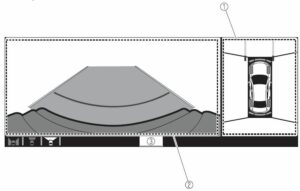
- Top view screen
- Front view screen
- Check surroundings for safety.” message is displayed
Top view/Front wide view
Displays the image of the area around the vehicle and the front of the vehicle (wide-area).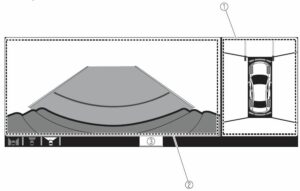
- Top view screen
- Front wide view screen
- “Check surroundings for safety.” message is displayed
Side view
Displays the image of the left and right sides of the vehicle.
- Left side view screen
- Right side view screen
- “Check surroundings for safety.” message is displayed.
Top view/Rear view
Displays the image of the area around the vehicle and the rear of the vehicle.
- Top view screen
- Rear view screen
- “Check surroundings for safety.” message is displayed.
Top view/Rear wide view
Displays the image of the area around the vehicle and the rear of the vehicle (wide-area).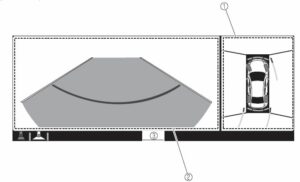
- Top view screen
- Rear wide view screen
- “Check surroundings for safety.” message is displayed.
How to Use the System
Top view/Front view, Top view/Front wide view, Side view.
Indication
Images are displayed on the screen when the 360° View Monitor switch is pressed with all of the following conditions met.
- The ignition is switched ON.
- The shift lever/selector lever is in a position other than R.

Display switching
The displayed screen can be changed each time the 360° View Monitor switch is pressed.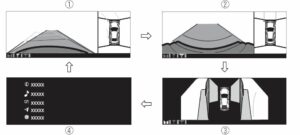
- Top view/Front view
- Top view/Front wide view
- Side view
- Home screen
NOTE
- When the shift lever/selector lever is in R position, the displayed screen does not switch to the top view/front view, top view/front wide view, or the side view.
- Display of the top view/front view, top view/front wide view, or the side view stops even with the display conditions met if any of the following conditions occurs.
- When a switch around the commander knob is pressed.
- (Manual transmission)
The parking brake is applied. - (Automatic transmission)
The selector lever is shifted to P position (displayed when the selector lever is in a position other than P). - (Displayed when vehicle speed is less than 15 km/h (9.3 mph))
- 4 minutes and 30 seconds have passed.
- The vehicle speed is about 15 km/h (9.3 mph) or faster.
- (Displayed when the vehicle speed is about 15 km/h (9.3 mph) or faster)
- The vehicle speed is about 15 km/h (9.3 mph) or faster after 8 seconds have passed since pressing the 360° View Monitor switch.
- 4 minutes and 22 seconds have passed from the point when the vehicle speed was less than 15 km/h (9.3 mph) after 8 seconds have passed since pressing the 360° View Monitor switch.
- The 360° View Monitor settings can be changed as follows.
Refer to the Settings section in the Mazda Connect Owner’s Manual. - Automatic display of the 360° View Monitor when the ultrasonic sensor detects an obstruction.
- Automatic display of the 360° View Monitor when the ignition is switched ON.
- Screen priority level when the system launches.
Top view/Rear view, Top view/Rear wide view
The top view/rear view, top view/rear wide view displays when all of the following conditions are met.
- The ignition is switched ON.
- Shift lever/selector lever is in R position.
Display switching
The displayed screen can be changed each time the 360° View Monitor switch is pressed.
- Top view/Rear view
- Top view/Rear wide view
NOTE
- The top view/rear view and top view/rear wide view automatically display whether or not the 360° View Monitor switch is turned on or off when shifting the shift lever/selector lever to R position.
- The top view/rear view and top view/rear wide view displays the previously displayed screen.
- The setting can be changed to display the top view/front view when shifting from reverse to a forward gear without operating the 360° View Monitor switch to check the front of the vehicle while parallel parking.
- Refer to the Settings section in the Mazda Connect Owner’s Manual.
WARNING
Always stop the vehicle when adjusting the 360° View Monitor image quality. Do not adjust the 360° View Monitor image quality while driving. If you adjust the 360° View Monitor image quality (such as brightness, contrast, tone, and color density) while driving, it could lead to an unexpected accident.
|
|
Display/Icon |
Content |
| (1) | View status icon |
Indicates which image is displayed among the front view/front wide view/side view/rear view/rear wide view. |
| (2) | Parking sensor status icon |
Indicates that the parking sensor has a problem or it is switched off. |
Top View/Front View
Use the top view/front view to assist in checking the safety of the surrounding area when accelerating from a stop, parking, or stopping the vehicle.
Display range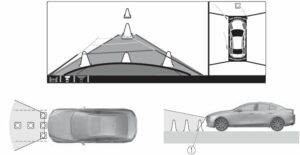
- Target object
NOTE
- In the top view screen, the areas in black at the front and rear of the vehicle image and the seams where each of the camera images merge are blind spots.
- Because images displayed in the top view screen are processed from each camera, the top view screen may display in the following ways.
- Depending on the surrounding environment, the color of objects may be displayed on the screen in a color different from the actual one.
- Depending on the surrounding environment, it may take a few seconds for the color of the screen display to adjust.
- Obstructions displayed in the front view may not display on the top view screen.
- If the position or angle of each camera changes due to tilting of the vehicle, the image may appear distorted.
- Lines on the road may appear distorted at the seams where each of the camera images merge.
- The screen area for each camera may appear bright/dark depending on the illumination level around any of the cameras.
Viewing the screen
| Display/Icon | Content | |
| (1) | Tire icon | Indicates the tire direction. Moves in conjunction with the steering wheel operation. |
| (2) | Projected vehicle path lines (yellow & red) | Indicates the approximate projected path of the vehicle. Moves in conjunction with the steering wheel operation.
Indicates the path where the edge of the front bumper is expected to travel. |
| (3) | Extended vehicle width lines (blue) |
|
| (4) | Projected vehicle path distance guidelines (yellow & red) | Indicates the distance (from the front end of bumper) in front of the vehicle.
The red line indicates the point about 0.5 m (19 in) from the front end of the bumper. |
CAUTION
The parking sensor detection range has limitations. For example, obstructions closing in from the side and objects short in height may not be detected. Always confirm the safety around the vehicle visually when driving. For details, refer to the parking sensor obstruction detection indication and warning sound. Refer to Parking Sensor System on page 4-247.
NOTE
The setting can be changed so that the projected vehicle path lines are not displayed.
Refer to the Settings section in the Mazda Connect Owner’s Manual.
How to use the projected vehicle path line function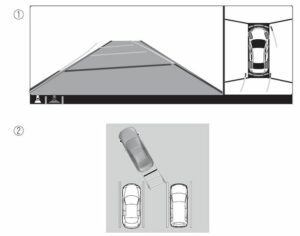
- (Screen display)
- (Actual condition)
Make sure that there are no obstructions within the projected vehicle path lines. Drive the vehicle forward while turning the steering wheel so that no obstructions come within the projected vehicle path lines.
Top View/Front Wide View
Use the top view/front wide view to assist in checking the safety of the surrounding area when accelerating from a stop or entering a T-shaped intersection and intersection.
Display range
- Target object
NOTE
- In the top view screen, the areas in black at the front and rear of the vehicle image and the seams where each of the camera images merge are blind spots.
- Because images displayed in the top view screen are processed from each camera, the top view screen may display in the following ways.
- Depending on the surrounding environment, the color of objects may be displayed on the screen in a color different from the actual one.
- Depending on the surrounding environment, it may take a few seconds for the color of the screen display to adjust.
- Obstructions displayed in the front view may not display on the top view screen.
- If the position or angle of each camera changes due to tilting of the vehicle, the image may appear distorted.
- Lines on the road may appear distorted at the seams where each of the camera images merge.
- The screen area for each camera may appear bright/dark depending on the illumination level around any of the cameras.
Viewing the screen
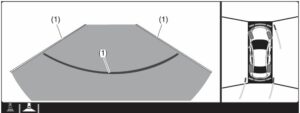
| Display/Icon | Content | |
| (1) | Extended vehicle width lines and distance guide lines (blue & red) | Indicates the approximate width of the vehicle and the distance (from front end of bumper) in front of the vehicle.
|
NOTE
The front wide view screen displays the image in front of the vehicle at a wide angle and corrects the image to help detect approaching obstructions from the side. Therefore, it differs from the actual view.
Side View
Use the side view to assist in checking the safety of the surrounding area when accelerating from a stop, parking, or stopping the vehicle.
Display range
- Target object
Viewing the screen
| Display/Icon | Content | |
| (1) | Projected vehicle path lines (yellow) | Indicates the approximate projected path of the vehicle. Moves in conjunction with the steering wheel operation. The projected vehicle path lines (yellow) indicate the path the inner side of the vehicle is expected to travel. |
| (2) | Vehicle parallel guide lines (blue) | Indicates the approximate vehicle width including the door mirrors. |
| (3) | Vehicle front end guide lines (blue) | Indicates the point about 0.25 m (9.84 in) from the front edge of the vehicle (front edge of the bumper). |
NOTE
The setting can be changed so that the projected vehicle path lines are not displayed.
Refer to the Settings section in the Mazda Connect Owner’s Manual.
How to use the projected vehicle path line function
- (Screen display)
- (Actual condition)
Make sure that there are no obstructions within the projected vehicle path lines. Turn the steering wheel so that the projected vehicle path lines travel inside of the obstruction (A), and drive the vehicle forward until it passes the obstruction. If the projected vehicle path lines are on an obstruction (B) or outside of the obstruction (C), the vehicle may contact the obstruction when turning the vehicle sharply.
CAUTION
- The parking sensor detection range has limitations. For example, obstructions closing in from the side and objects short in height may not be detected. Always confirm the safety around the vehicle visually when driving. For details, refer to the parking sensor obstruction detection indication and warning sound. Refer to Parking Sensor System.
- Do not turn the steering wheel any more until the vehicle has passed the obstruction, even if the obstruction is not visible on the side view image. If the steering wheel is turned even more, the vehicle may contact the obstruction if it is turned sharply.
NOTE
- Because there might be a difference between the image displayed on the screen and the actual conditions, always check the safety of the surrounding area using the mirrors and directly with your eyes when driving.
- Even though the object displayed on the screen, such as a road curb or a division line of a parking space, and the vehicle parallel guide lines appear parallel, they may not actually be parallel.
Top View/Rear View
Use the top view/rear view to assist in checking the safety of the surrounding area when accelerating from a stop, parking, or stopping the vehicle.
Range of displayed screen image
- Target object
NOTE
- In the top view screen, the areas in black at the front and rear of the vehicle image and the seams where each of the camera images merge are blind spots.
- Because images displayed in the top view screen are processed from each camera, the top view screen may display in the following ways.
- Depending on the surrounding environment, the color of objects may be displayed on the screen in a color different from the actual one.
- Depending on the surrounding environment, it may take a few seconds for the color of the screen display to adjust.
- Obstructions displayed in the rear view may not display on the top view screen.
- If the position or angle of each camera changes due to tilting of the vehicle, the image may appear distorted.
- Lines on the road may appear distorted at the seams where each of the camera images merge.
- The screen area for each camera may appear bright/dark depending on the illumination level around any of the cameras.
Viewing the screen
| Display/Icon | Content | |
| (1) | Tire icon | Indicates the tire direction. Moves in conjunction with the steering wheel operation. |
| (2) | Projected vehicle path lines (yellow & red) | Indicates the approximate projected path of the vehicle. Moves in conjunction with the steering wheel operation.
|
| (3) | Extended vehicle width lines (blue) | These guide lines indicate the approximate width of the vehicle. |
| (4) | Projected vehicle path distance guide lines (yellow & red) | These guide lines indicate the approximate distance to a point measured from the rear of the vehicle (from the end of the bumper).
|
NOTE
The setting can be changed so that the projected vehicle path lines are not displayed.
Refer to the Settings section in the Mazda Connect Owner’s Manual.
How to use the projected vehicle path line function
CAUTION
- The front of the vehicle swings out wide when turning the steering wheel while reversing. Maintain sufficient distance between the vehicle and an obstruction.
The parking sensor detection range has limitations. For example, obstructions closing in from the side and objects short in height may not be detected. Always confirm the safety around the vehicle visually when driving. - For details, refer to the parking sensor obstruction detection indication and warning sound.
NOTE
- Because there might be a difference between the image displayed on the screen, such as indicated in the following, and the actual conditions when parking, always check the safety at the rear of the vehicle and the surrounding area directly with your eyes.
- Even though the back end of the parking space (or garage) displayed on the screen and distance guide lines appear parallel, they may not actually be parallel.
- When parking in a space with a division line on only one side of the parking space, even though the division line and the vehicle width guide line appear parallel, they may not actually be parallel.
- The following shows an example of vehicle parking with the steering wheel turned to the left while backing up the vehicle. When backing into a parking space from the opposite direction, the steering operation is reversed.
- Back the vehicle into the parking space by turning the steering wheel so that the vehicle enters the center of the parking space.

- (Screen display)
- (Actual condition)
- After the vehicle starts entering the parking space, stop and adjust the steering wheel so that the distance between the vehicle width lines and the sides of the parking space on the left and right are roughly equal, and then continue backing up slowly.
- Once the vehicle width lines and the sides of the parking space on the left and right are parallel, straighten the wheels and back the vehicle slowly into the parking space. Continue checking the vehicle’s surroundings and then stop the vehicle in the best possible position. (If the parking space has division lines, check whether the vehicle width guide lines are parallel to them.)
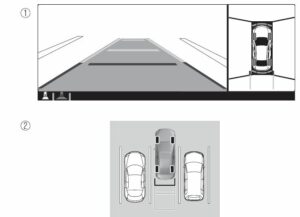 (Screen display)
(Screen display)
- (Actual condition)
Top View/Rear Wide View
Use the top view/rear wide view to assist in checking the safety of the surrounding area when accelerating from a stop, parking, or stopping the vehicle.
Range of displayed screen image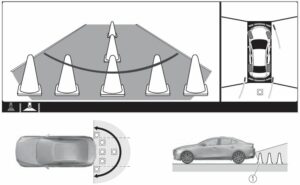
- Target object
NOTE
- In the top view screen, the areas in black at the front and rear of the vehicle image and the seams where each of the camera images merge are blind spots.
- Because images displayed in the top view screen are processed from each camera, the top view screen may display in the following ways.
- Depending on the surrounding environment, the color of objects may be displayed on the screen in a color different from the actual one.
- Depending on the surrounding environment, it may take a few seconds for the color of the screen display to adjust.
- Obstructions displayed in the front view may not display on the top view screen.
- If the position or angle of each camera changes due to tilting of the vehicle, the image may appear distorted.
- Lines on the road may appear distorted at the seams where each of the camera images merge.
- The screen area for each camera may appear bright/dark depending on the illumination level around any of the cameras.
Viewing the screen

| Display/Icon | Content | |
| (1) | Extended vehicle width lines and distance guide lines (blue & red) | These guide lines indicate the approximate width of the vehicle and distance to a point measured from the rear of the vehicle (from the end of the bumper).
The red lines indicate the points up to about 0.5 m (19 in) from the rear end of the bumper. |
NOTE
The top view/rear wide view screen displays the image at the rear of the vehicle at a wide angle and corrects the image to help detect approaching obstructions from the side. Therefore, it differs from the actual view.
Margin of Error Between Road Surface on Screen and Actual Road Surface
There might be some margin of error between the road surface appearing on the screen and the actual road surface. A margin of error in the perceived distance could lead to an accident, therefore be aware of the following conditions which can more easily produce errors in the perceived distance. The vehicle tilts due to weight of passengers and cargo. If the vehicle is tilted, obstructions picked up by a camera can appear farther or closer than the actual distance from the vehicle.
Front camera
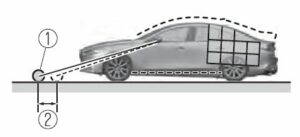
- Obstruction
- Margin of error
Side camera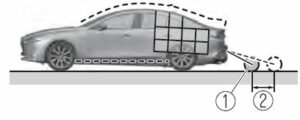
- Obstruction
- Margin of error
Rear camera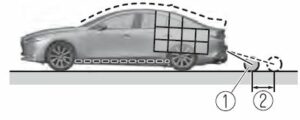 There is a steep up or down grade in the road at the front or rear of the vehicle
There is a steep up or down grade in the road at the front or rear of the vehicle
If there is a steep up or down grade in the road at the front or rear of the vehicle, obstructions picked up by the camera can appear farther or closer than the actual distance from the vehicle.
Front camera
- Appears further than actual distance
- Distance of obstruction being viewed on screen
- Actual distance of obstruction from vehicle
- Actual obstruction
- Obstruction appearing on screen
- Appears closer than actual distance
Side camera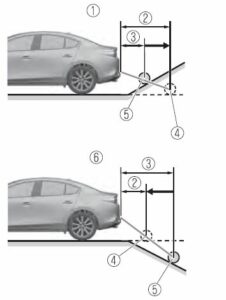
- Appears further than actual distance
- Distance of obstruction being viewed on screen
- Actual distance of obstruction from vehicle
- Actual obstruction
- Obstruction appearing on screen
- Appears closer than actual distance
Rear camera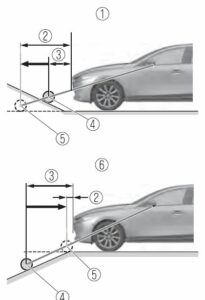
- Appears further than actual distance
- Distance of obstruction being viewed on screen
- Actual distance of obstruction from vehicle
- Obstruction appearing on screen
- Actual obstruction
- Appears closer than actual distance
NOTE
If the vehicle is on a slope, obstructions taken by the camera can appear farther or closer than the actual distance from the vehicle.
Three-dimensional object at vehicle front or rear
Because the vehicle front end guide lines (side camera) or the distance guide lines (rear camera) are displayed based on a flat surface, the distance to the three-dimensional object displayed on the screen is different from the actual distance.
Side camera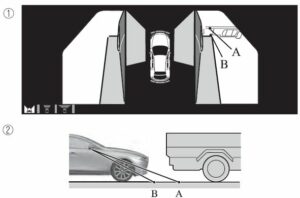
- (Screen display)
- (Actual condition)
Rear camera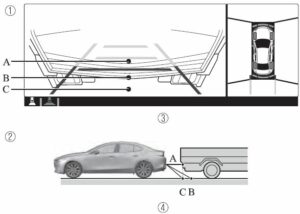
- (Screen display)
- (Actual condition)
- Sensed distance on screen A>B>C
- Actual distance B>C=A
System Problem Indication
| Center display indication | Cause | Action to be taken |
| “No camera signal.” is displayed | The control unit might be damaged. | Have your vehicle inspected by an Authorized Mazda Dealer. |
| Screen is pitch-black and blank | The camera might be damaged. |
FAQs
The Lane-keep aid System (LKAS) is an advanced driver assistance technology that provides steering inputs or alerts when the vehicle begins to drift out of its lane in order to aid drivers in maintaining their lane.
The LKAS in the Mazda 3 Hatchback 2023 makes use of a forward-facing camera to keep an eye on road lane markers. It can recognize when the car is veering off course and gently corrects it by steering to keep it in its lane.
No, the Mazda 3 Hatchback 2023 does not always have the Lane-keep Assist System on. Using the settings or control panel of the car, the driver can enable or disable it.
In the Mazda 3 Hatchback 2023, the Lane-keep Assist System can be disabled or overridden. Typically, the system can be turned off by pushing a button or going into the settings of the car.
Yes, the Mazda 3 Hatchback 2023’s Lane-keep Assist System can function at a variety of speeds in both city and highway driving situations.
Yes, the Mazda 3 Hatchback 2023’s Lane-keep Assist System is built to tackle curves and bends in the road. In order to maintain the car centered within the lane, it modifies the steering inputs accordingly.
The Mazda 3 Hatchback 2023’s Lane-keep Assist System is commonly set up to recognize deliberate lane changes made by the driver. In such circumstances, it won’t apply steering inputs or obstruct the driver’s movements.
The Lane-keep Assist System is not meant to take the role of attentive driving. It is made to help the driver by adding assistance and lowering the possibility of unintentional lane changes. Driving requires constant focus and engagement from the driver.
Depending on the weather, the Lane-keep Assist System’s ability to recognize lane markers can change. It could have drawbacks when there is a lot of snow, rain, or fog since the lane markers might be covered.
Yes, the Mazda 3 Hatchback 2023’s Lane-keep Assist System can issue both visible and audio alerts to the driver if the car begins to veer off its lane without a turn signal being used.
While the Mazda 3 Hatchback 2023’s Lane-keep Assist technology can help lower the risk of accidents brought on by unintended lane departures, it’s vital to remember that no technology can completely guarantee accident prevention. For safe driving, the driver’s focus and attentiveness are still essential.
Depending on the trim level and extra features, the Lane-keep Assist System may not always be available. packages picked out for the 2023 Mazda 3 Hatchback. For accurate information on trim-specific features, it is advisable to study the vehicle’s specs or get in touch with a Mazda dealership.
Useful Links
View Full User Guide: Mazda 3 Hatchback 2023 User Manual| Auto User Guide
Download Link: Owner’s – Manuals, Guides, Maintenance Schedules | Mazda USA
2023 Mazda 3 Hatchback Specs, Price, Features, Mileage (Brochure)
Related Article
2023 Mazda 3 Hatchback Specs, Price, Features, Mileage (Brochure)
2023 Mazda 3 Specs, Price, Features, Mileage (Brochure)

